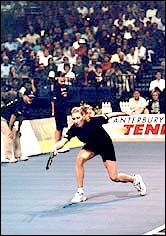Dorothy – 5/5/00
An interview with Maurice Agar, Chairman of Canterbury Tennis Incorporated
The Hilary Commission which is a major funder of sport throughout New Zealand undertakes research to assist in the allocation of funding. In the course of this research they found that the number of New Zealanders who play tennis at least once a month is approximately 500,000, which makes tennis the biggest participant sport in the country. The only outdoor activities that rated more highly were walking, gardening, fishing and swimming, and as swimming included sea bathing this was not classified as sport.
Maurice Agar’s involvement in tennis
|
|
| Maurie Agar Photo source Maurie Agar |
Mention tennis to Maurie Agar and immediately his face lights up. He has had a love affair with tennis for over fifty years.
It all began on the volley board at Diamond Harbour, a seaside village on the Lyttelton Harbour. Nine year old Maurie began playing with a racquet that had only just enough strings for him to hit the ball. Dorothy Hart, then a top woman Canterbury player, noted his enthusiasm – and his racquet – and gave him one of her cast offs which Maurie describes as ‘a brilliant racquet’ and his entry into the tennis world was secure. He played in tournaments at Wilding Park in Christchurch from the age of eleven and as he grew up played in representative teams for Canterbury. His enthusiasm has continued till now when he has veteran status, and he still enjoys playing as much as ever.
What is so good about tennis? Maurie has a string of reasons for describing tennis as a wonderful sport.
- It can be played as a social or competitive sport.
- It involves a huge number of juniors from an early age and helps them develop team spirit.
- It is a non-contact sport and injuries are rare.
- It is an equally good sport for both sexes and gives good opportunities for mixed doubles and social activities.
- It is a great family sport. Maurie and his wife Judy played doubles with and against their sons until they became too good for their parents!!
- Because of the new surfaces tennis is now played summer and winter. Synthetic grass can be played on almost immediately after rain.
- You can play tennis with just one other person. It is not necessary to organise a team to play.
- Last but not least, it is a sport for all ages – from four to ninety.
Maurie’s voluntary work for tennis Maurie has given generously of his time to the organisation of tennis. First he was invited to join the Canterbury Junior Lawn Tennis Association Committee. After serving there for three years he became its chairman – an office he held for six years. He moved from there to the Canterbury Lawn Tennis Association Committee, and on the resignation of the chairman six months later he was prevailed upon to take over the position which he still holds after nineteen years in the role. He has served for nineteen years on the Policy Council of New Zealand Tennis and has been a vice President and President of New Zealand Tennis Inc.
How is the sport organised?
Zealand Tennis Incorporated – a board of seven and a staff of three is responsible for creating policy and strategies for the general direction of the sport, and financial governance.
Twenty four Tennis Associations throughout New Zealand organise tennis activities in their areas. The chairpersons meet with the national body formally twice a year, but are actually in day to day communication. They organise junior and senior activities – coaching, competitions, tournaments and international and social events in their areas.
Maori Tennis Association This group, which is affiliated to New Zealand Tennis Inc, works to assist Maori players, especially juniors.
Wheel Chair Tennis Association This group is also affiliated to New Zealand Tennis Inc. and organises local and international events for disabled players.
The New Zealand Umpires Association is also an affiliated member of New Zealand Tennis Inc.
The Canterbury Lawn Tennis Association (CLTA) Founded in 1890 this is the second largest association. Auckland which has the biggest population is the largest association. Canterbury Tennis Incorporated (CTI), as it is now called, administers tennis in the Canterbury area from the Rangitata River to the Conway River. Although with the rural downturn some country clubs struggle, most have survived. There are presently twenty eight city clubs and seventy two rural clubs throughout the Canterbury Province.
It organises all the inter club competitions. CTI has 320 junior teams playing every Saturday. These involve over 1500 players and umpteen parents who act as chauffeurs and minders. Every court available is used. 150 senior teams play at the weekends, involving approximately 700 players.
There is a huge midweek ladies’ competition organised by the clubs and mens’ and mixed competitions also attract a lot of players.
Visit of Steffi Graf – a very special occasion The Auckland Association initiated the visit of this tennis star and Canterbury Tennis paid the expenses and organised the sponsorship required for the extension of her visit to Christchurch. Her exhibition match in Christchurch was played in front of the biggest tennis crowd in the history of New Zealand tennis.
|
|
| Steffi Graf In Action Photo Source CTI |
She played a singles match against the Australian player, Jelena Dokic, and they were partnered for an entertaining doubles match by two prominent footballers, Andrew Mehrtens and Matthew Ridge.
|
|
| Television presenter Mark Leishman talks to Steffi Graf with Mehrts in the background Photo Source CTI |
Davis Cup matches The Associations organise Davis Cup matches. Canterbury has hosted the largest number because Christchurch has been able to provide a grass court surface. The most recent challenge was held in Timaru which has a relatively new tennis centre.
There are 132 countries at present competing in the Davis Cup worldwide. New Zealand with a population of less than four million is frequently in the top twenty four countries which is a significant achievement.
The New Zealand team has recently played in a Davis Cup match in Uzbekistan – and unfortunately lost!
Fed Cup The Fed Cup is an equivalent competition for women. New Zealand has had teams competing, but has not achieved the same success as in the Davis Cup. However, Maurie is encouraged by the number of very good young players coming up.
Coaching gifted young players A huge effort in terms of finance and organisation has been made to improve the coaching of young players, but this is very expensive as they have to go to Europe to experience the different surfaces on which matches are played. Despite these efforts New Zealand tennis still struggles to compete with the huge competition from countries with bigger populations.
“We may have one outstanding fourteen year old whereas Australia may have ten,” Maurie said. “It is not through lack of effort and finance that we currently have no one under 200 on the world ranking list, whereas in the past we had distinguished players like
Anthony Wilding, Chris Lewis, Onny Parun, Belinda Caldwell and Brett Steven.”
At age thirteen or fourteen New Zealand players go to Australia and compete well, but then the gap starts to widen. Maurie believes that this is due to the lack of competition here. Also players have been handicapped by the lack of indoor facilities.
Indoor tennis facilities There has been rapid change in recent years, and there are now at least eight indoor facilities in New Zealand, mainly in the larger cities.
The Scenic Circle Hotels Tennis Centre at Wilding Park in Christchurch Scenic Circle Hotels is the sponsor of the new six court Indoor Tennis Centre at Wilding Park. The surface of these courts is Rebound Ace.
|
|
| The Scenic Circle Indoor Tennis Centre Photo Source CTI |
The importance of insulation The Scenic Circle Hotels Tennis Centre is insulated through the roof and the sides. The planners of the Christchurch centre were able to learn from the experiences at earlier centres. Elsewhere without adequate insulation there have been condensation problems in frosty weather. The insulation keeps the centre cool in summer, warm in winter, and free of condensation problems.
The new building includes six courts, a new stand, administration offices, a lounge which will accommodate 150 people, a cafeteria, bar and kitchen, a lift for disabled people, and a pro shop. The pro shop and the catering are leased out.
The future of tennis in New Zealand Canterbury Tennis Inc. initiative Young people today have a wide choice of sports in which they can be involved. CTI has received funding to develop a huge school programme in which coaches go to 110 primary and intermediate schools and give coaching to 17,000 children. The facilities at the schools are rather limited, but the children are put in touch with the local clubs.
Maurie has had so much enjoyment himself from tennis that it is a joy to him to know that at an early age the children are getting a good introduction to the sport of tennis which can give a lifetime of pleasure from playing an active and sociable sport.







